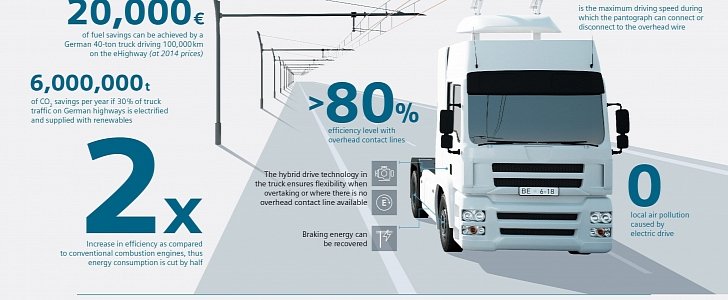While you might feel as though personal automobiles get all the stick for the air pollution caused by road transportation, the long-distance hauling trucks are actually just as much to blame.
The vast majority of them have big diesel engines, and the emission regulations for this type of vehicles are not as strict as with the passenger cars. Sure, they have stuff like AdBlue and, much like their smaller counterparts, diesel engines in trucks have come a long way too regarding efficiency, but at the end of the day, a truck still pollutes more than a handful of cars.
Which is why converting big rigs to use electric power would cut road transport emissions a great deal. Some companies, Tesla included, believe the same solution of having charging stations scattered all over the existing road infrastructure, as with passenger cars, is the best way to go forward, but others are not convinced.
Instead, the suggest the installment of overhead contact lines that the trucks could use to charge their batteries on the move. This seems a lot more practical, but it has its drawbacks nonetheless.
For one thing, it requires special infrastructure elements, ones that won't be useful to any other vehicles than trucks. Second, they'll need to stretch over long distances to provide significant charge, especially since the vehicles would be draining the batteries at the same time. Finally, we already have vehicles for shipping goods that use overhead lines, and they're called 'trains.'
Obviously, the electric trucks would bring the added benefit of being able to go 'off-track,' offering more flexibility and much-improved accessibility. At the moment, though, nobody can say whether the advantages outweigh the impediments, so a real-world test run is required.
A ten-kilometer stretch (a little over six miles) of the A5 Autobahn in Germany, between the Frankfurt Airport and the Darmstadt/Weiterstadt interchange, is going to be fitted with the suspended charging system. The project, called eHighway, is managed by Siemens, but it has official government backing as well.
They say the trucks can go as fast as 90 km/h (56 mph), which is close to their usual cruising speed of 100 km/h (62 mph), which means they shouldn't cause any traffic problems. And since the first lane on any German Autobahn is full of trucks anyway, that wouldn't have been a problem regardless.
There is no clue on when the construction is expected to finish or when we'll know how successful the initiative has been, but if you start seeing wires hanging over the first lane on the highway you commute on, then you can consider that question answered.
Which is why converting big rigs to use electric power would cut road transport emissions a great deal. Some companies, Tesla included, believe the same solution of having charging stations scattered all over the existing road infrastructure, as with passenger cars, is the best way to go forward, but others are not convinced.
Instead, the suggest the installment of overhead contact lines that the trucks could use to charge their batteries on the move. This seems a lot more practical, but it has its drawbacks nonetheless.
For one thing, it requires special infrastructure elements, ones that won't be useful to any other vehicles than trucks. Second, they'll need to stretch over long distances to provide significant charge, especially since the vehicles would be draining the batteries at the same time. Finally, we already have vehicles for shipping goods that use overhead lines, and they're called 'trains.'
Obviously, the electric trucks would bring the added benefit of being able to go 'off-track,' offering more flexibility and much-improved accessibility. At the moment, though, nobody can say whether the advantages outweigh the impediments, so a real-world test run is required.
A ten-kilometer stretch (a little over six miles) of the A5 Autobahn in Germany, between the Frankfurt Airport and the Darmstadt/Weiterstadt interchange, is going to be fitted with the suspended charging system. The project, called eHighway, is managed by Siemens, but it has official government backing as well.
They say the trucks can go as fast as 90 km/h (56 mph), which is close to their usual cruising speed of 100 km/h (62 mph), which means they shouldn't cause any traffic problems. And since the first lane on any German Autobahn is full of trucks anyway, that wouldn't have been a problem regardless.
There is no clue on when the construction is expected to finish or when we'll know how successful the initiative has been, but if you start seeing wires hanging over the first lane on the highway you commute on, then you can consider that question answered.




